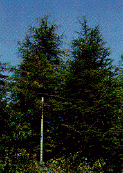
The Department for Forestry
The area in which the Institute is active is characterized by the rocky terrain with greatly pronounced
processes of erosion. Erosion as a scientific and a practical problem , and furthermore "melioration" in a
loose translation is the problem of soil conservation, conservation and improvement of fertility, and its
producing valori zation- all this represents a wide group of problems that many of the coworkers of the
institute have had to deal with.
With these problems came to full expression the complex character of the Institute because the possibility
of a close collaboration amongst coworkers of different specialties and scientific direction came to be
witnessed.
In 1962 rearranged was the Institute for forestry and hunting research in Croatia, and its forestry testing
station in Split connects to this Institute. This way the Institute took over the scientific research program of
the station and developed its research activity in forestry problematics on the Adriatic area
and developed the melioration of degraded forest surfaces on rocky terrain. Inside of that program
researched were the possibilities and methods of forest meliorations on rocky terrain, basic erosion
parameters, biological and nurturing
characteristics of particular forest types, introduction of new forest types, and the phytocellular research of
vegetation on rocky terrain. This united the scientific research problematics of erosion and meliorization of
agricultural and
forest surfaces in these regions. From that conjugation resulted numbers of studies in the framework of
developing area planning on the entire Adriatic region. The basic content and goal of those studies, inside
that area, that were based on economic, ecologic, and human character was to get an optimal position and
its optimal application, that will connect to general economic development in that region. On those
principles are worked the researches and studies for the regional area of "South Adriatic", "Northern
Adriatic", and the islands Hvar, Solta, Brač and others.
Beside the mentioned research the Institute worked on the history of Dalmatian forestry, problems of
recultivation of damaged grounds, the damaging effects of the fire on the vegetation, biotope and the
landscape of coastal areas, and the longterm development of forestry in Dalmatia.
From 1980 to 1990, the Department worked on making up programs for maintaining the forests and
their grounds in the narrow rocky terrain areas of Dalmatia. With this function the Department is tied to
almost all of the forest services in Dalmatia.
In the last few years the Department worked on the following scientific research projects and tasks:
Maintaining the rocky terrain forests intended for animal husbandry
Selection of types and methods of biologic meliorizations.
Erosion and protection of soil on rocky terrains.

The research of the most suitable forms of forests for animal feeding in rocky terrains , has a goal of
such a maintenance that would secure a large and qualitative production of animal feed in the forests,
while on the other hand it would direct the development of forest vegetation towards a progressive road of
advancing and protecting the ecosystem. The selection of types when repopulating the forest, especially in
the rocky terrain, has always been the basic question of the forestry field, on which little has been done up
to today . With this goal were established testing level surfaces on rocky terrain, for performing this type
of research.
The process of erosion has been present in our rocky terrains for a long time.
The witnesses of the truthful confirmation are limitless in number concerning the water worn ravines,
gulleys and uncared for pastures, immense barren mountains in places were there once were forests and
degraded underbrush that is still regressing. In the framework of longterm research, the Institute
established a few testing level surfaces where stationed contemporary methods will be implemented with a
goal of arriving at some original facts concerning some valuable characteristics of the erosion process of
the soil by water and stream swelling in the region that is representational of the lithic terrain in the
coastal Croatia.

